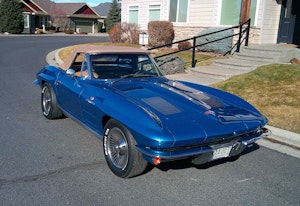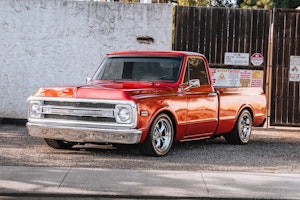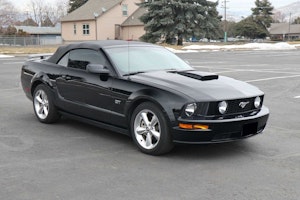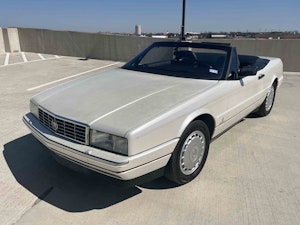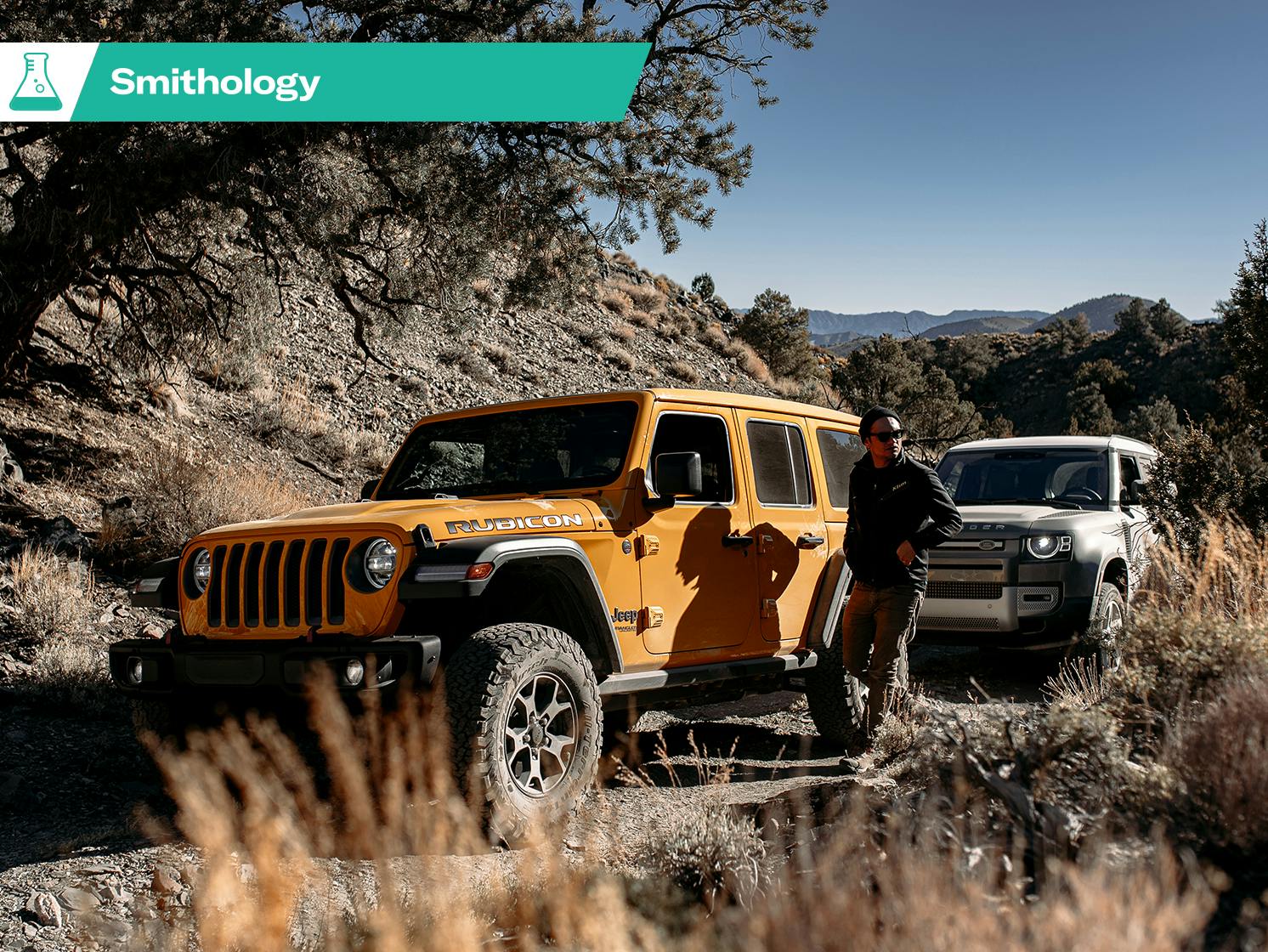Media | Articles
Smithology: The Land Rover Defender asks the Jeep Wrangler to STEP OUTSIDE!

Last year, I went to the high Sierra to chase low-flying military jets for this website. Photographer Camden Thrasher and I took a 2020 Land Rover Defender 110 and a 2020 Jeep Wrangler Unlimited Rubicon Ecodiesel into the mountains near Death Valley. We spent several days perched on remote hilltops, watching the skies.
That tale will soon be serialized here. It’s a fun story—jets tear through the sky and men traverse remote and unpaved mountains. The feature focuses little on the trucks in question, however, so we’ve prepared a quick primer on the Jeep and Landie: some of what three days in the desert will teach you about each, and the manner in which two very different machines approach the same task.
Questions? Thoughts? Relevant personal experience with Land Rovers and Jeeps of any vintage? Let us know in the comments—we’d love to hear from you.
Enjoy!
—Sam
Marketplace
Buy and sell classics with confidence
***
2021 Jeep Wrangler Unlimited Rubicon Ecodiesel
Base price/as-tested: $33,470 (base Wrangler Unlimited) / $58,315
Drivetrain: 3.0-liter turbcharged diesel V-6, 260 hp, 442 lb-ft, 8-speed automatic.

WHAT IS IT?
A utilitarian, four-wheel-drive, body-on-frame SUV with two live axles, a manual transfer case, and low range. The “Unlimited” bit means four doors; the Wrangler is also available as a two-door model with a shorter wheelbase, or as a long-wheelbase pickup. The Rubicon moniker represents an off-road trim package that brings, among other things, unique suspension tuning, shorter final-drive ratios, uprated Dana axles, an electronically disconnectable front sway bar, and 33-inch tires. A host of engines are available, running the gamut from a four-cylinder hybrid to a 470-hp, 6.4-liter V-8. Gearboxes are limited to either a six-speed manual or an eight-speed automatic; some drivetrains, like the diesel V-6, are only available with the automatic.
But Jeeps are widely understood, so you probably knew that.
STRONGEST SELLING POINT:
A deep sense of off-road focus and purpose. Jeep has been making a vehicle like this, in a form obviously related to this machine, since the middle of the last century. There is real heritage here, blended with genuine capability and a deep-seated sense of inevitable: You buy a Wrangler because it makes tractoring around town feel like an event, and because you might one day end up on a lumpy gravel two-track or Fins and Things in Moab. Many people buy a Jeep simply because they want a reason to find places like that.

WHY WE PICKED THIS ONE FOR THE TRIP:
When you decide to go off-roading in America, the question isn’t so much which vehicle as which Jeep. It is the gold standard, the bar by which everything else in the class is measured. As for this vehicle in particular, the V-6 diesel has gobs of character and torque and feels purposeful. The Rubicon package is deeply capable off-road without sacrificing highway stability and comfort. The four-door is big enough to camp out of and sleep in.
On a personal note, your author has a preference for two-door Wranglers with crank windows and manual transmissions, but then, my tendencies lean toward lightly masochistic tradition. The two-door Wrangler is more pitchy over rough roads (that short wheelbase rearing its head), and genuinely less practical in a number of ways. Want another reason to get the four-door? It offers as much cargo space with its rear seats up as a two-door Wrangler offers with the rear seats down.

WHAT SETS IT APART FROM THE LAND ROVER
A not-insignificant dose of American traditionalism, and the feeling that you’re driving a simple tool. (Even though no modern car is in any way simple, even one with a ladder frame and two solid axles.) A heavy sense of purpose and rough-edged durability. The fact that the cabin is awash with stamped-steel edges and untrimmed metal, and that those details are features, not bugs. The presence of modern telematics—Bluetooth, navigation, a decent touchscreen—but also an upright dash close to your body, flat glass, and a vague nod to 1960s ergonomics. The fact that you can find Wrangler parts in any small town in America, on something like a moment’s notice, without spending a fortune.
The Wrangler is more narrow in body and taller than the Defender; it carves a similar footprint on trail and highway but feels more close-coupled, more of an implement. Its steering has less to say but helps produce a smaller turning circle. Visibility is about even between the two, and quite good for a modern vehicle—each truck is easy to see out of, with the sole exception of a light blind spot in the rear three-quarter (a heavy blind spot on the Defender, if you spec the ridiculous optional cargo “fanny pack”).

The engine sounds gnarly—industrial, clattery, to-the-point. It redlines at 5000 rpm but is happiest below four grand, and most content tootling around at low rpm. The diesel also offers the best fuel economy (21/ 26 EPA city/hwy with Rubicon package, 22/29 without) of any non-hybrid Wrangler. Good torque just off idle and a relatively low dose of lag make trail crawling brainless. Power is far easier to modulate than in the Land Rover—the forced-induction Landie tends to want a far more delicate foot at low speed, and smoothness over uneven terrain is more elusive.
The Jeep’s doors come off, and its windshield folds. Its roof can be dismantled either partially or fully, depending on how you spec your truck at the dealer. (The Defender is currently only available with either a fixed steel roof or one of two large sunroof options.) Bare-bones hardtop? Insulated hardtop for reduced road noise? Soft top? Hardtop (insulated or bare) with removable sun panels? Pick your poison; each has its strengths. Strip the truck down, you’re left with little more than a roll cage and a few seats behind a hood. It is a bathtub of freedom and fresh air. Your bones loofah with the suds of possibility.
The Jeep aftermarket is best described as enormous. It has been enormous for literally decades. A host of parts exist to make your truck look and feel different or perform better in a variety of ways. The Defender’s aftermarket support is best described as… present. Punch the phrase “Jeep Wrangler aftermarket” into Google, you get nearly 19 million results. The words “Land Rover Defender aftermarket,” produce roughly a tenth of that.
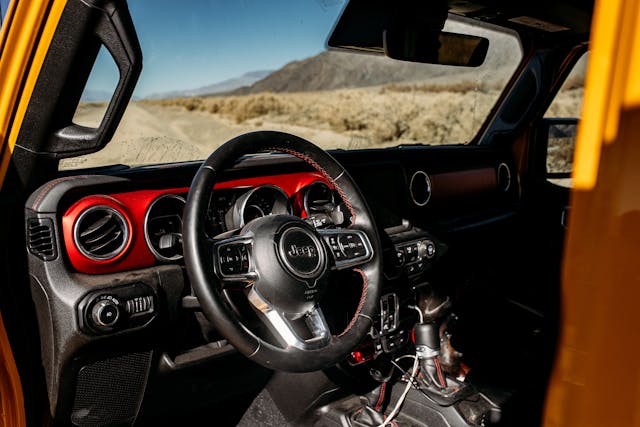
If the Jeep’s interior is a stack of vertical surfaces, whiffing of agriculture, the Land Rover is all space and glass. For all its exterior size, hopping into a Wrangler still feels like sliding on a comfy old jacket. Credit a clever use of space, plus the fact that the Jeep’s footprint is larger than its body—big fenders and wheels far out from the cabin and visible. The interior can be cozier than you expect, given the footprint, but even the back seat is roomy enough for tall folk.
Perceived size off-road. The trails we met varied in size and demand—from graded gravel to two-track and then light to medium rock-crawling in narrow confines. Some of those trails would have been easily traversed by a ’57 Chevy; others were aided by locked diffs and a disconnected sway bar. The Land Rover wasn’t troubled but took more work to place and seemed larger than life. It also felt more ungainly and distant in tight quarters.
These nameplates began life, decades ago, at similar points but evolved differently. Each is rooted in midcentury ideas of quasi-military purpose and a bare-bones aesthetic; the first “Series” Land Rovers were very much like a midcentury Jeep, and arguably more focused and truckish. Next to the modern Defender, the Wrangler feels more analog and nimble, more of a single-minded tool and less of a lifestyle accessory.
The Defender is a trucklet that does a truck job in carlike fashion, straddling two purposes; the Jeep makes no bones about its roots and revels in them, from behavior to aesthetics. Only one gives the impression it can be fixed with farm tools, even though you know it probably can’t. The Jeep seems aimed more at hard knocks, and in these circles, that counts for a lot.

WINS:
Mountain-goat vibe and ability without huge compromise in road behavior. Feels built to fall off a mountain and keep going. You almost want to dent it and scrape the paint off. It’s a Jeep. What Jeep looks happiest clean and perfect?
Balance. Direct and linear steering. Massive suspension travel and articulation without twiddling a dial or waiting for a computer; it’s just present. Simple and obvious controls. Remarkably decent ride quality, given the ingredients. Good brake feel and a transmission that, although it isn’t a mind-reader, simply gets out of the way and does its job. The whole truck somehow manages to land the trick of registering as both simple, predictable device and complex modern vehicle. A rare feat these days.
Excellent visibility, and an interior that manages to provide gobs of legroom and atmosphere without losing a sense of cozy.
A mind-boggling number of factory options and models, across a broad spectrum of price. The configurator holds everything from a $28,000 Wrangler to variants costing as much as a small house.
World War II*. (Essentially.)
*This is a joke, made with love. Please do not write us detailing how the Wrangler has little in common with the 1940s vehicle that helped defeat tyranny. We know. Levity is a blessing.

LOSSES:
The traditional Wrangler downsides, nearly all of which are designed-in and intentional: NVH is significant, and the Jeep still rides like a live-axle truck. Sound deadening is virtually an afterthought. Certain people will find this stuff a deal-breaker, even given the Jeep’s capability; those people are perhaps not cut out for Wrangler ownership.
Platform bloat is real. The current Wrangler (JL chassis) is slightly larger in some dimensions than the previous Wrangler (JK), which was in turn slightly larger in some dimensions than the Wrangler before that (TJ). Jeeps were once small and nimble vehicles, and their size tended to aid passage down tight trails. Jeep designers have toyed with the idea of a “baby” Wrangler for years; such a model is unlikely to see the light of day, but the Wrangler’s big-boy dimensions make it nice to think about.
Price climbs rapidly as you add doors and off-road options/equipment.
The diesel is noisy, even for a diesel. The torque is nice, especially at low rpm, but the clatter can be annoying if you’re not a diesel sympathetic. (Diesympathizer?) The gas V-6 is a perfectly fine alternative, if a bit less entertainingly roughneck.
WHO WILL BUY IT?
Your narrator. A person very much like your narrator. Douglas MacArthur. Happy masochists. Traditionalists living in the present. Futurists living in the past. Preppers. People who think modern cars are too complicated. Anyone who loves the joy of a device that revels in a sense of egalitarian purpose.
***
2021 Land Rover Defender 110 SE
Base price/as-tested: $62,250 (Defender 110 SE) / $72,180
Drivetrain: 3.0-liter, turbocharged and supercharged I-6, 395 hp, 406 lb-ft, 8-speed automatic.
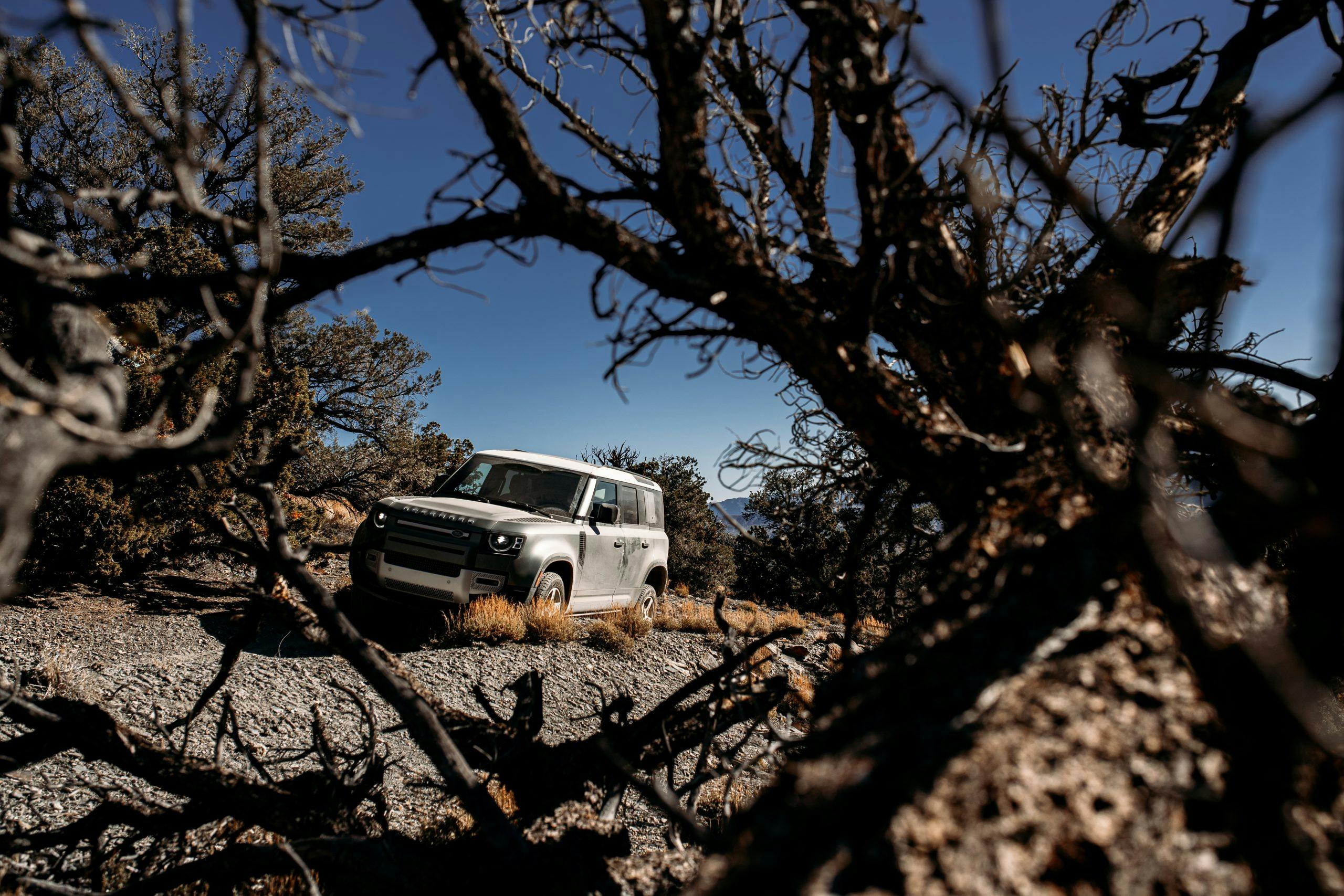
WHAT IS IT?
A hypermodern, four-wheel-drive, unibody SUV with independent front and rear suspension, electronically locking differentials, an eight-speed automatic, and more ground clearance (11.5 inches) and wading ability (35 inches of water) than can be had on a Wrangler. The available air suspension noticeably aids both clearance and ride comfort at anything other than full extension.
As with the Wrangler, there are a host of available configurations. Four accessory “packs” tailor the truck’s focus, from city-oriented (basically just tasteful trim bits) to hard-core (snorkel, side-mounted outside cargo carrier, integrated air compressor, an water “rinse” system that lets you hose off yourself or the truck, and so on). Drivetrain options include a 296-hp turbocharged 2.0-liter four; a 395-hp, turbocharged and supercharged, 3.0-liter inline six; and a 518-hp, supercharged, 5.0-liter V-8 arriving summer 2021.
The naming conventions are odd. Years ago, back when Land Rovers wore live axles and the Defender was a warmed-over farm truck, the Defender 90—the two-door model—offered a wheelbase close to 90 inches. The Defender 110, the four-door, carried a wheelbase close to 110 inches. In 2021, the Defender 90 is a two-door with a wheelbase of almost 102 inches, and the 110 clocks in at 119. The numbers are strictly an affectation.
This sort of discrepancy is ultimately trivial, but it is indicative of the thinking here: You don’t make those naming choices unless you’re on some level self-consciously chewing on the plain fare of your own past. Land Rover has built something like a Defender since the late 1940s. The current version is effectively the first ground-up redesign in the model’s history, and it says a great deal about Land Rover’s view of itself in the modern world. The shift in philosophy—from a Wrangler-like body-on-frame construction and two live axles, to a unibody/independent layout—is telling of focus, and of the Defender’s newfound infatuation with luxury manners and on-road behavior.
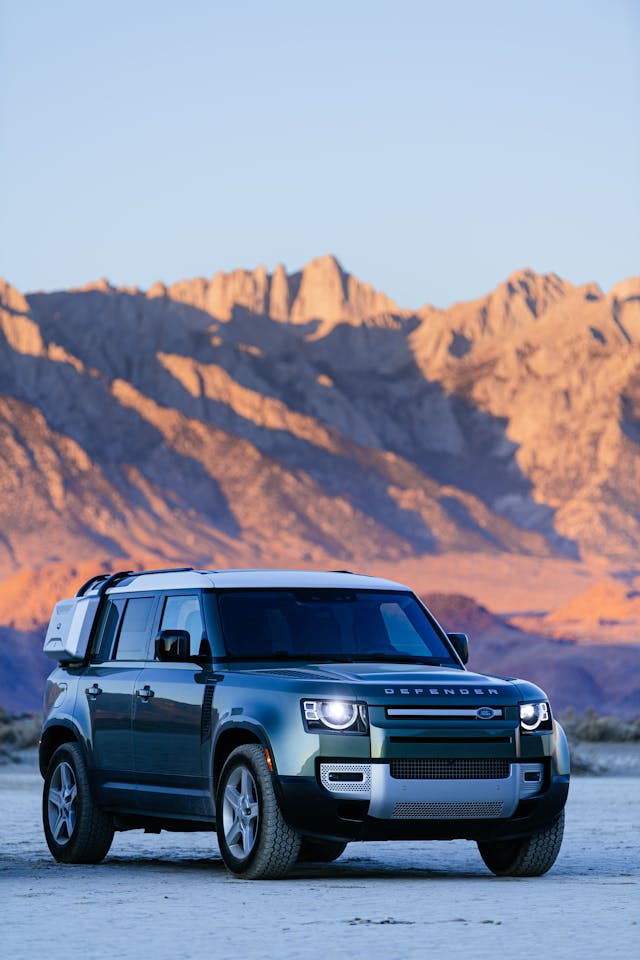
The old Defender felt like Wrangler meets John Deere. The new one feels not entirely unlike like somebody pulled all the leather from a Range Rover and shrunk it a bit. This choice was obviously made to help sales, and to satisfy what most Land/Range Rover customers expect from the brand.
Some folks believe that the Brits are at their best when laboring against the constraints of history and tradition. Others think the country’s car industry can occasionally pop out bits of greatness—an E-Type, a Lotus Elise, a Mini—but then spends years trying and failing to live up to those bright lights. Either way, a lot of thought and worry were put into this thing. And you can tell; it’s quite good. It is also very definitely not a Wrangler or an old Defender, for better or worse.
STRONGEST SELLING POINT:
The badge on the hood, and the way the Landie manages to combine the road manners of an upscale SUV with a sense of simple purpose and intense trail ability. There’s also exclusivity, after a fashion: Land Rover hasn’t sold new Defenders in America since 1997. You won’t see yourself coming and going in traffic, at least for a few years.
Plus, it just looks cool. Sahara safari Camel Trophy zebras-across-the-veldt elephant-pith-hat cheerio-toodle-pip cool.
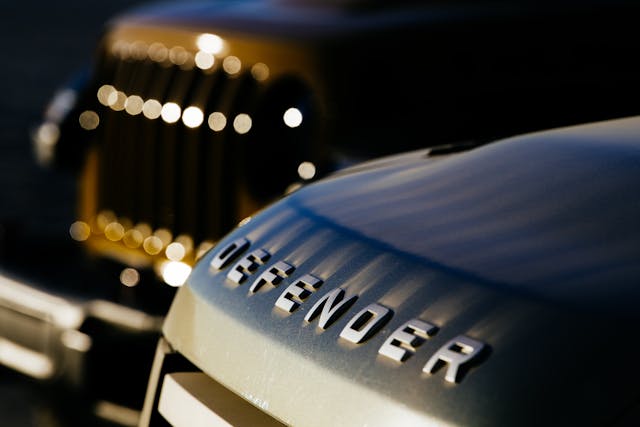
WHY WE PICKED THIS ONE FOR THE TRIP:
The Defender is brand-new and something of a reckoning for Land Rover; it’s not every day that an ancient brand remakes its North Star. As for this particular spec, the V-8 wasn’t yet available, and with a base price close to $100,000 (!), that truck is far from good value anyway. The four-cylinder variant is nice, but the six produces more than 100 lb-ft more and offers slightly better highway fuel economy. (17/22 EPA city/highway for the six versus 18/21 for the four.)
On a personal note, your author has a preference for two-door Defenders without the silly optional side exterior cargo carrier, but then, I’m also a lightly practical dork who reads too much history. That said, we camped in these trucks during the jet feature, and the 110 offers a nearly flat rear cargo area with its seats folded. It’s far more comfortable for sleeping.

WHAT SETS IT APART FROM THE JEEP?
A sense of British romanticism, and a hint at how the English have long traded egalitarian freedom and constant reinvention for a sense of propriety and reverence for the past. (Consider how the London of now looks much like the London of 100 years ago, whereas New York City seems to renew its buildings and culture every other week.)
Ironically, of course, the Jeep is far more steeped in tradition here, and the Land Rover is far more of a reinvention. Not just in construction and layout. The Defender’s edges and forms can make it seem more unwieldy than the Jeep, as if you were driving a shipping container. From the driver’s seat, you see a wide dash and long, flat hood, with none of the Jeep’s immediate visual reassurance as to the location of the wheels or bumpers. It’s entirely possible to park the Jeep in tight quarters or nudge it down a close trail without scraping paint or getting nervous; the Defender, by contrast, seems to crowd into traffic and always make you wonder if you’ve just ground off a taillight on a pedestrian or dead rabbit.

That said, it’s definitely a more comfortable place to be. The Landie has a remarkable amount of glass for a modern vehicle, and it uses that glass well; the interior is light and airy, even with the shade pulled on the optional sunroof. The Defender also feels less claustrophobic than the Jeep. Our test vehicle featured a rubberlike composite flooring in place of carpet, and most of the interior surfaces were covered in hard-wearing plastics. The Landie’s seats felt more supportive and slightly more geared toward long hours in the saddle. A few touches come off as affectations—the tiny Alpine windows in the roof, which don’t let in much light or scenery; the exposed Torx fasteners in the doors; that exterior cargo carrier—but only because the rest of the truck is so straightforward.
About that cargo carrier: Despite being closed and locked during our testing, the carrier rapidly filled with silt and sand. It has little room inside. The latch perpetually seemed two seconds away from breaking in half. If there’s a point here, it’s not obvious.
On-road behavior is classically and pleasantly British, which is to say, softly sprung but quite firmly damped and long in suspension travel. Communicative in satisfying fashion. Like the Jeep or a good pickup (or many Land Rovers), the Defender works well on a good back road and is oddly satisfying to hustle. There’s good balance here, and fluidity. The gearbox is remarkably intuitive, especially in sport mode, and good at guessing which gear is needed to keep the six awake. From a personality standpoint, think of it as the Jaguar Mk. II sedan to the Jeep’s ’63 Corvette: Fine instrument versus blunt instrument. You can use much of the Defender’s tire at relatively low speed, without endangering yourself or others. Largely because the controls and chassis talk back.
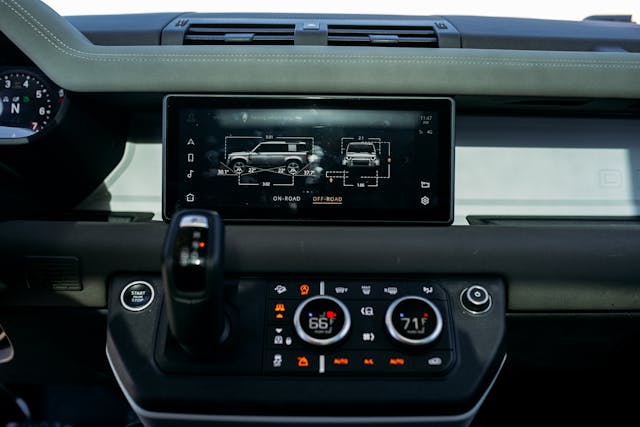
Trails flip the script: The Landie’s gearbox can be harsh in manual mode. Uneven and oddly unpredictable power delivery at low rpm can make it difficult to balance the truck at low speed. The air suspension lacks travel at trail ride height/preload too often seems annoyingly stiff. There’s more irritating head toss. The Defender’s various selectable electronic trail modes (grass/gravel/snow, mud and ruts, sand, rock crawl, etc.) make a noticeable difference, but I’d happily trade them all for a single suspension and drivetrain calibration good at most things.
The Jeep seems to carry its weight lower, and it rides better over rumbly gravel or nasty, rock-strewn paths. On a section of rutted two-track, at a 14-degree incline, the Jeep simply grumbled over rocks in a series of soft little compressed motions, nimble and loose in the knees, while the the Land Rover felt constantly ill at ease and uptight.

Killer stereo, though. The Land Rover’s Meridian system is genuinely delightful—not hugely versatile, but lovely on anything with some swing or delicate gestures. Soundstaging is quite nice, and while the system can be a little sharp up top and boomy in the mids, it feels organic.
All of this contributes to the feeling that the Jeep was born outdoors and dragged into respectability, where the Land Rover is the opposite—an ordinary car that escaped into the unpaved world. The Defender is perfectly happy on the dirt, but a stint in the Jeep on similar surface can make it feel like an awful lot of unnecessary work.
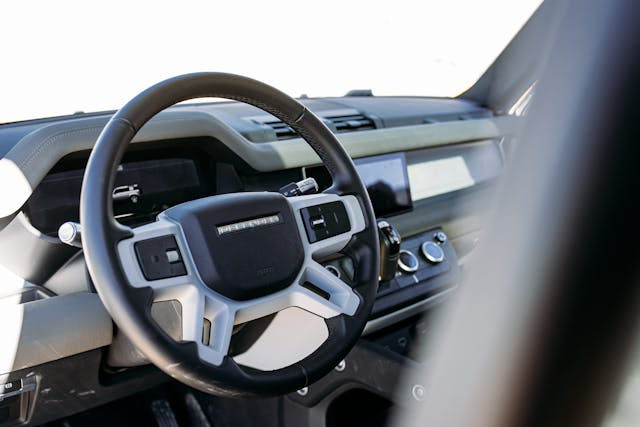
WINS:
Simple and clean lines, exceptional ride and handling for the class, quality stereo, fun to hustle on pavement.
Interior is a nice mix of tasteful simplicity and durable materials.
As a package, the whole thing feels genuinely special in a way that’s both inarguable and hard to describe.
LOSSES:
That silky forced-induction six can be laggy and annoying off-road; smoothness takes a careful right foot and a lot of thought. The Wrangler’s drivetrain and chassis feel like an easy button by comparison.
Price—which is not low to begin with—climbs rapidly as you add doors and off-road options/equipment. Buy a V-8 110 or option a six-cylinder with all the off-road goodies, you’re looking at Porsche 911 money. Value is not the argument here.
No available manual transmission, just that eight-speed automatic. Manuals are less suited for trail work but ultimately more fun in many ways, and if you’re not buying a rock hound for fun, well, what are you doing? (Most Wrangler drivetrains are available with a manual for a reason.)
Where the Jeep’s exterior bits seem designed to be dragged along brush and bumped into trees—a lot of hard-wearing finishes or simple plastics—the Landie seems far more cosmetically delicate, and easier to damage. The Defender tends to feel like a focused and simplified version of Land Rover’s usual bag of tricks, not the genuinely special tool deserved by the name.
WHO WILL BUY IT?
Off-road enthusiasts who see the price of entry as little roadblock and a Mercedes G-Wagen as too garish. Trail hounds who won’t mind Land Rover’s modern reputation for high maintenance. (Worst marque in the country on J.D. Power’s 2020 dependability study.) Those who loved the old Defender but hated how it drove like a coked-up tractor. Anyone who owns a Belstaff jacket that has never been wet. Dr. Livingstone. (I mean, presumably.)

SO WHAT’S THE TAKEAWAY?
If you’re searching for a bare-bones machines designed for the middle of nowhere, you probably know exactly what you want. One of these machines will speak to your heart, and the other will seem as wrong as a blizzard in June. Both, however, are remarkably good answers to a fun question and unique on the market. In the end, that’s all that matters.
Sam Smith is an editor-at-large with Hagerty. He came to the company after an eight-year stint at Road & Track, where he served as both executive editor and editor-at-large. He has written for outlets as diverse as Wired and The New York Times and was once employed as the world’s slowest professional mechanic. He lives in Tennessee with a very rusty BMW 2002, a small collection of motorcycles, and a very patient wife.
Follow him on Instagram and Twitter: @thatsamsmith
